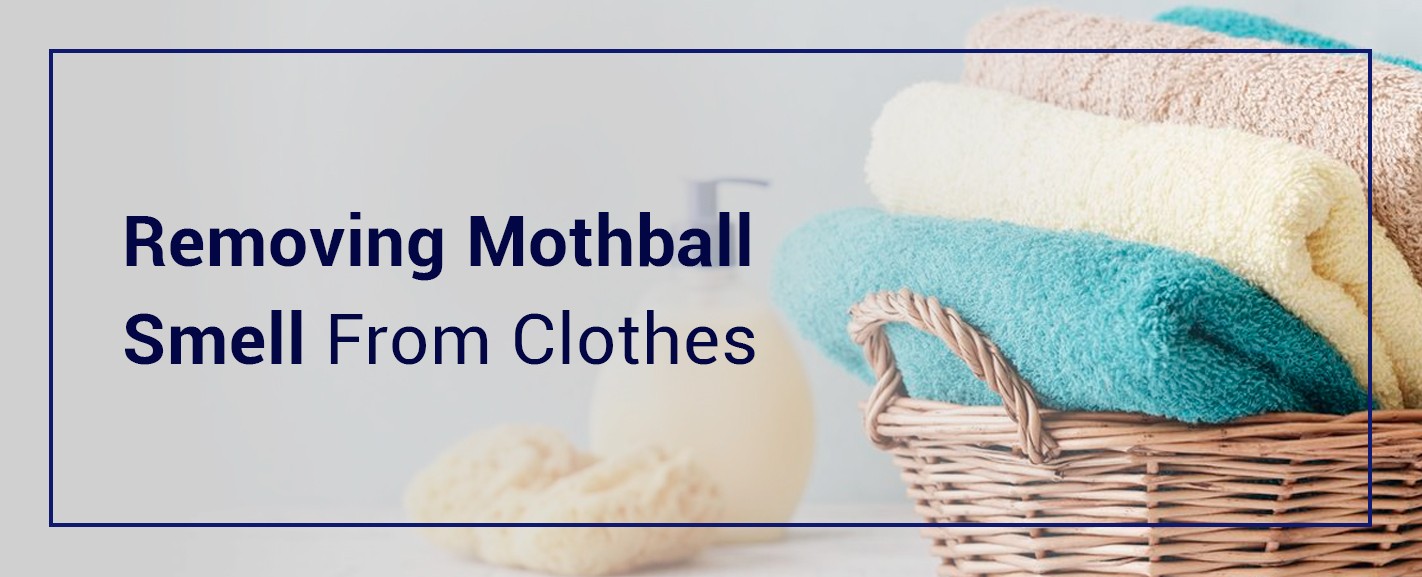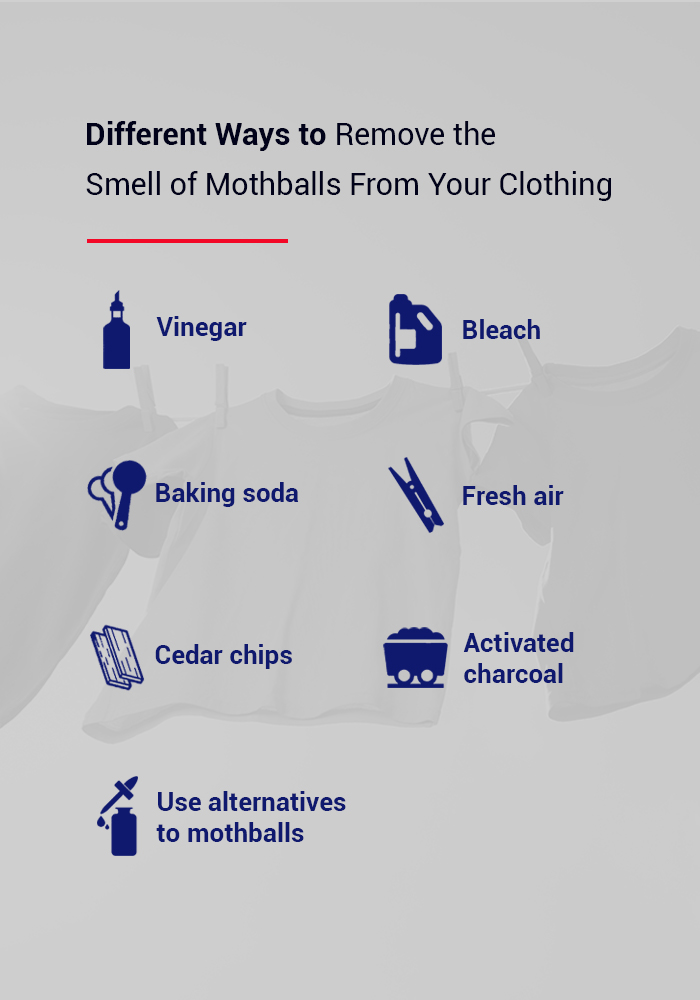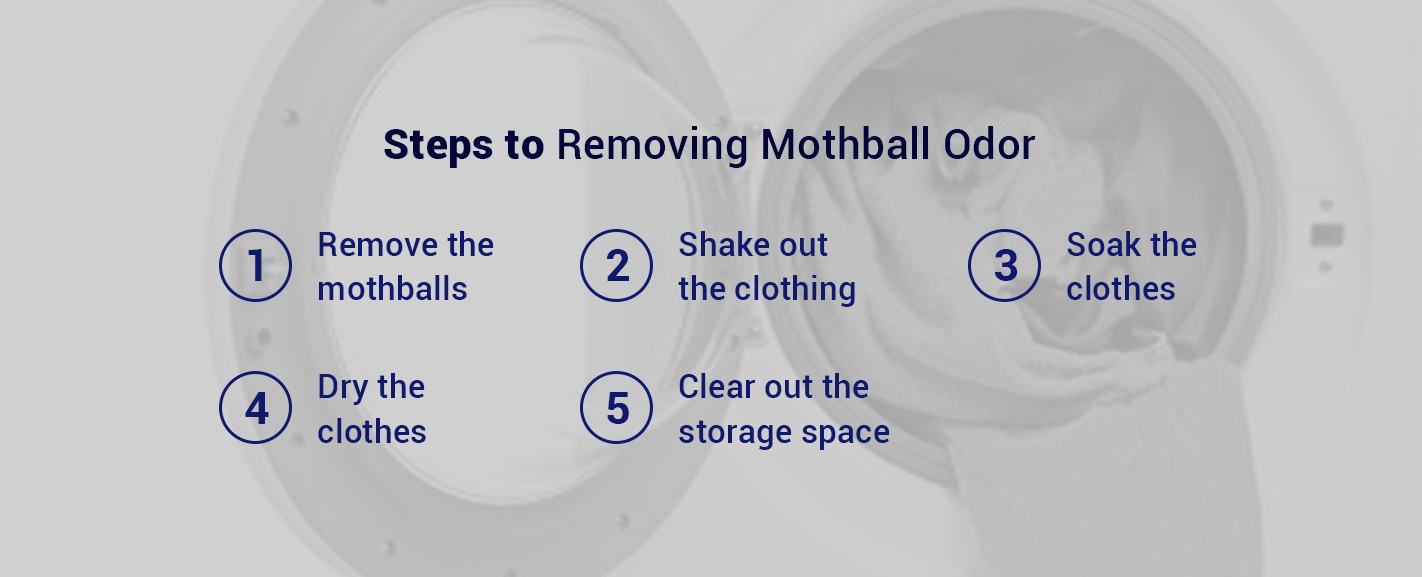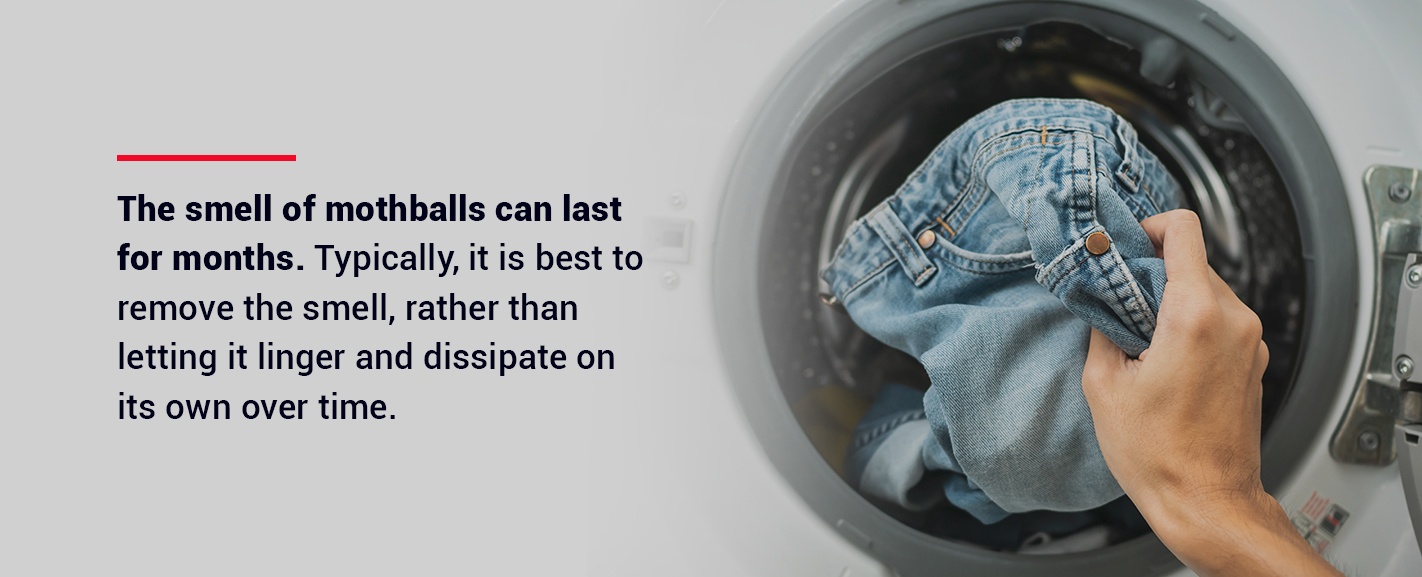
With the change of seasons, an entire portion of your wardrobe often goes into storage. You want light, cotton shirts, dresses and shorts where you can reach them during the summer. Heavy, woolen coats and sweaters head to the back of the closet, or you fold them and place them in a dresser. You might not think of those items of clothing until the first crisp hint of fall weather, but once the temperature drops, you want it all to be in good condition. That is why many people store their off-season clothing with mothballs.
Mothballs are an excellent deterrent for moths, their larvae and any number of other insects that could damage your clothing. Mothballs are a pesticidal product containing the chemicals naphthalene or paradichlorobenzene. While they are undoubtedly effective at keeping your clothing safe, the odor of mothballs can linger long after you take your clothes out of storage. Learn effective ways to combat the pungent smell of mothballs and get your winter clothing ready for the season.
Different Ways to get rid of the Smell of Mothballs From Your Clothing
Mothballs can last up to four to six weeks, and they can last even longer if you store your garments in a tightly sealed container. Regardless of how long the mothballs last before they dissolve, the smell will likely last longer. The mothball odor clings to your clothing, which gives your winter clothes a pungent and unpleasant smell. Here are a few straightforward ways to remove that mothball smell for items that can washed and dried. If you have dry clean only items, we do not recommend all of these methods below.
- Vinegar: Vinegar is a go-to solution for many household odor issues, and the smell of mothballs is no exception. For delicate items of clothing, you can soak them in a bucket. Place the clothes in the bucket with one part vinegar to eight parts warm water. Let them sit for an hour before carefully rinsing with clean water and then allowing them to dry. Use white vinegar to avoid any potential staining. Vinegar is also an effective solution for clothing that can run through the washing machine. Place your garments in the machine with a cup of vinegar and allow it to run through a cycle. Next, run another cycle with detergent as you normally would. Once the clothes have finished both cycles, they should be free of the mothball smell. If you notice a lingering odor, you can repeat the process. Be careful to entirely remove the smell before allowing your clothes to air dry or go through a dryer cycle.
Bleach: If you have sturdy clothing that can handle the effects of bleach, this is another effective odor removal solution. First, check that you have non-chlorine bleach. Then, you can run a laundry cycle in the washing machine with bleach and water. Read the care instructions on your clothing and the instructions on the bleach bottle to ensure that this method is safe for your clothing.
- Baking soda: You might be in the habit of keeping a container of baking soda in your refrigerator to reduce any smells in the appliance. Baking soda’s absorbent powers can benefit your winter clothing, too. You soak your clothing in a bucket with a cup of baking soda, or you can run a wash cycle in the machine with a cup of baking soda and your usual amount of detergent. If any smell remains, repeat the process.
- Fresh air: Fresh air is a natural, hands-off approach to removing the smell of mothballs. Take your clothing outside and hang it in the sun for several hours. The open space can help the smell dissipate without allowing it to spread indoors. This option is typically best for milder odors. Make sure to check the weather report. You don’t want any rain to soak your clothing and add the smell of mildew to your list of concerns. Try airing clothing out immediately, or you can hang wet clothes outside to dry on a sunny day. Before bringing them inside again, check to see if the smell has completely gone. If not, you will need to try another method.
- Cedar chips: Cedar has a strong, but pleasant, smell. Chips of the wood can protect clothing from insects, and it can also help with the smell of mothballs. Place any affected clothing in a sealable container with cedar chips for a few days. This tactic can be helpful in cases of stubborn odors that linger even after multiple rounds of washing.
- Activated charcoal: Activated charcoal is another highly absorbent substance that can help remove the smell of mothballs. You buy sachets of activated charcoal to hang in your closet or place in your dresser drawers.
- Use alternatives to mothballs: If the smell of mothballs gets to be too much of a hassle, or if you think the downsides outweigh the benefits, you can consider using an alternative solution. Essential oils are a common, and natural, way to prevent insects from damaging your garments. You carefully apply essential oils, such as lavender oil, to the inside of your dresser drawers or other storage containers. You can also make DIY sachets out of whole botanicals. For example, lavender blossoms, cloves, cinnamon sticks and rosemary are all effective insect repellents. Plus, these items leave a pleasant smell you do not have to worry about when you take your clothing out of storage. If you decide to go this route, remember to refresh your sachets each year.
If you prefer an odor-free option to preserve your clothing, you can store seasonal items in airtight containers.
Steps to getting rid of Mothball Odor
There are multiple different methods for removing the smell of mothballs. Here is a simple step-by-step guide to follow when using nearly any odor removal method.
- Remove the mothballs: Mothballs dissolve over time, but you may find there are still some intact when you go to take your clothing out of storage. Remove any whole or partial mothballs and dispose of them properly. They contain toxic chemicals, which makes them hazardous household materials. Place the mothballs in an airtight container and find out if there is a nearby disposal facility. If the facility only has designated drop-off dates, it is safe to keep the mothballs in that sealed container. Be sure to wear gloves while handling the mothballs, and thoroughly wash your hands after you finish.
- Shake out the clothing: Your clothing may be hanging in a closet with mothballs, or you may have left it carefully folded in dresser drawers or storage containers. When you remove the clothes for the winter season, carefully shake them out. This practice can help a bit of the musty smell of mothballs dissipate. If you can, shake the clothing out while you are outside. You can then hang the garments in the sun, which can further help the smell dissipate safely. If you cannot hang them outdoors, allow them to hang in the laundry room while you prepare to wash them. If you find any pieces of mothball left on the clothing, carefully remove them. Be sure to wash your hands after handling any mothballs.
- Soak the clothes: After you shake your garments out, you can move on to soaking them. This process is a pivotal step in removing the smell of mothballs. Use your washing machine for sturdy clothes, but place more delicate items in a bucket to soak. You can use various household supplies to remove the odor, including white vinegar, non-chlorine bleach or baking soda. All of these have powerful odor-reducing properties. After one soak, either in the bucket or washing machine, smell the clothing. If there is any remaining scent of mothballs, repeat this step. You do not want to put clothes that still smell of mothballs into the dryer. As with a stain, the heat could cause the smell to set in the fabric.
- Dry the clothes: Once your clothing is odor-free, follow the care instructions to dry them. Drying can mean placing them flat to air dry or putting them in the dryer. Always check which dryer settings are best for each item of clothing. If you find soaking the clothes is not working, allow the fabric to air dry. Then, take the garments with a stubborn smell to a dry cleaning or laundry service.
- Clear out the storage space: Your clothing may not be the only thing that smells of mothballs. The closet, dresser or storage space that held the clothing and mothballs may also have a persistent smell. If the storage space in question is a small dresser, you can take it outside for a few hours every day to air out. The smell will slowly dissipate over time. You can also use a hairdryer to help speed up the process, but you should only do this in well-ventilated spaces.
If the furniture is too heavy to move outside or you have a closet filled with the smell of mothballs, the best way to deal with the odor is to absorb it. You can try several different substances to reduce and remove the scent. In the case of a dresser, you can stuff the drawers with balled-up paper. For a closet or dresser, you can fill small bowls with different types of odor-absorbent substances, such as vinegar, baking soda or activated charcoal. Allow the bowls to sit for a few days, then dispose of the contents. If the smell is still present, repeat the process with fresh bowls.
Interesting Facts and Other Useful Information About Mothballs
Mothballs are pesticides intended for sealed clothing storage. Over the years, many individuals have advertised other uses for mothballs outside and inside the home. To clear up the confusion about where and how you should use mothballs, we’ve answered common questions about these pesticides:
- What’s with people using mothballs outside? You can find blogs all over the Internet telling you to use mothballs as outdoor pesticides. Unfortunately, mothballs are not intended for outdoor use, as they can contaminate water, soil, and wildlife. Their toxic odor can also contribute to air pollution.
- Is it illegal to use mothballs outside? When you buy mothballs, you should see a detailed label that describes instructions for use. This label is an EPA-approved legal document that users are expected to follow. If you do not see the EPA logo on your mothball package, it could be unregulated and illegal to use. EPA-regulated mothballs are not legal to use outside because they can harm children, pets, or other wildlife. We recommend alternative pesticides for outdoor use.
- Is using mothballs in your attic safe? Mothballs should not be in any unsealed space, including attics, closets, or open trunks. These pesticides are chemically heavier than air and can make your attic an unsafe place to breathe in.
- Is it safe to use mothballs under your house? As with your attic, mothballs should not be under your house. Because of your home’s heating or cooling systems, fumes can travel through the air around your house. Mothballs need to be tightly sealed so they can’t create smells in any space inside or outside your home.
- Can mothballs make you sick? As long as you store and measure your mothballs correctly, the smell should not make you sick. If stored incorrectly, you could experience short-term symptoms like headaches or nausea. Long-term exposure can cause health problems with your blood cells or liver.
What to Do If Your House Suddenly Smells Like Mothballs
Mothballs have a unique and distinct smell. If your house suddenly smells like mothballs, there’s a chance they were stored improperly. The EPA advises against any other uses for mothballs except sealed clothing storage, so it’s best to investigate that strange odor. Leaving it untreated could pose serious health risks.
Mothballs create a strong smell from chemical fumes. If unsealed, this odor sticks to surfaces over time and can cause that sudden smell throughout your home. The first thing we recommend to get rid of the smell is removing any stray mothballs in the attic, basement, closet, or bedroom. Mothballs should never be left unsealed in your home and are likely the cause of the smell.
Those classic mothball odors stick to floors first, so we suggest cleaning multiple times. Homeowners with hard floors can mop with a baking soda and water solution. Make sure you open a window as you clean and finish by leaving a bowl of coffee grounds, activated charcoal, or vinegar to absorb any remaining odor. Rooms with rugs or carpets may require a rug cleaner.
Frequently Asked Questions About Mothballs
Mothballs are a common household item, which means people have a lot of the same questions about them. Here are the answers to some standard mothball queries.
- Will the smell of mothballs go away? Mothballs can last for more than a month, but the odor will cling to clothes and linger. The smell of mothballs, while pervasive, is not permanent. If you want to get rid of the smell, you need to remove any remaining mothballs, clean out the storage space and clean the affected clothing.
- How long does the smell of mothballs last? The smell of mothballs can last for months. Typically, it is best to remove the smell, rather than letting it linger and dissipate on its own over time. Once you decide to get rid of the scent, you can usually do so within a few hours or over a couple of days.
- How do you get rid of the smell of mothballs? The odor of mothballs is not pleasant, but there are various ways to getting rid of it. You can throw out the mothballs, clean out the storage space and wash or dry clean your clothing to eliminate the smell. Different household products like vinegar, bleach and baking soda can help you mitigate and remove the smell.
- Is the smell of mothballs dangerous? Mothballs contain pesticidal chemicals. While these are effective at protecting your clothes, you should understand the associated risks. Though brief exposure to the smell of mothballs is usually safe, breathing in the fumes of mothballs over a prolonged period can cause headaches, dizziness, difficulty breathing, nausea and vomiting. You’ll want to remove the smell quickly and effectively. Mothballs are also dangerous if ingested. The chemical naphthalene can damage your red blood cells. Always wash your hands after handling mothballs or articles of clothing that smell of mothballs. You should also take precautions if there are children and pets in your home. Small, round mothballs can look like edible treats to kids and dogs. Store mothballs securely, and ensure children and pets cannot accidentally stumble upon them.
- Will dry cleaning remove the smell of mothballs? The scent of mothballs can be stubborn. If you are worried you won’t be able to remove the odor yourself, or you would prefer professional help, dry cleaning might do the trick.
Get Help for Your Mothball Odors With Professional Dry Cleaning
If you are struggling with the unpleasant smell of mothballs, we can help. Classic Drycleaners has dry cleaning locations, laundromats, wash-and-fold laundry services and free pickup and delivery in the Greater Harrisburg area. Take your winter clothes out of storage and let us help you get them ready to wear.
Sources:
1. https://www.bobvila.com/articles/how-to-get-rid-of-mothball-smell/
2. https://www.thriftyfun.com/Removing-Mothball-Odor-from-Clothing-1.html
3. https://www.hunker.com/13420312/how-to-remove-mothball-odor-from-clothing
5. https://grandfolk.com/guide/how-to-get-mothball-smell-out-of-clothing/
6. https://creativehomemaking.com/cleaning/laundry/mothball-smell/
7. https://blogs.webmd.com/from-our-archives/20110222/are-mothballs-safe
8. https://www.ridmycritters.com/how-to-get-rid-of-mothball-smell/
9. https://www.classicdrycleaner.com/locations/
10. https://www.pgeveryday.com/home/cleaning/alternatives-for-mothballs
11. https://www.bestpickreports.com/blog/post/make-your-own-natural-alternatives-to-mothballs
12. https://www.buyactivatedcharcoal.com/remove_mothball_odor
13. https://www.poison.org/articles/2008-oct/taking-your-woolies-out-of-mothballs
14. http://npic.orst.edu/factsheets/naphgen.html
15. http://gmcleaners.com/consumer-tips/
16. https://www.hunker.com/12563353/how-to-dispose-of-mothballs
17. https://homeguides.sfgate.com/getting-smell-mothballs-out-furniture-97116.html
Tags: mothball odor





